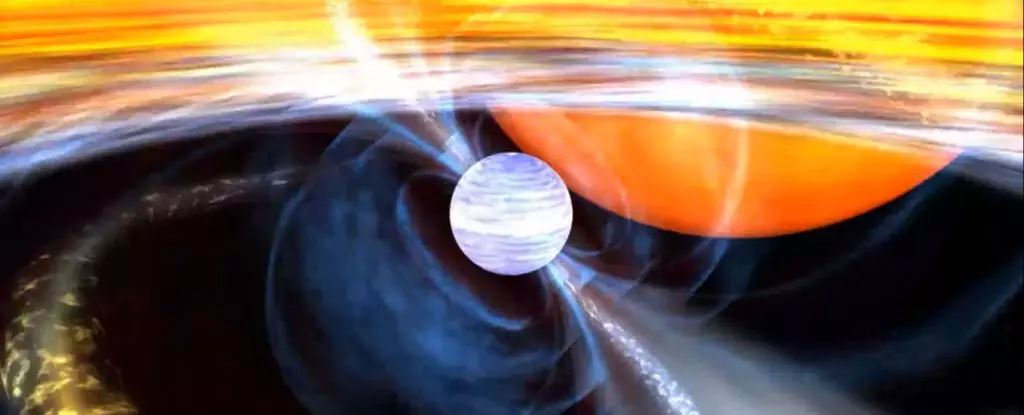In a remarkable cosmic find, the binary system 4U 1820-30, located 27,400 light-years away in the constellation Sagittarius, has piqued the interest of astronomers with the discovery of an extraordinary phenomenon. Here, a neutron star spins with astonishing speed, clocking in at 716 rotations per second. As the hunt for the fastest-spinning objects in the universe continues, this neutron star claims a position among elite company, rivaling even the acclaimed pulsar PSR J1748-2446ad. Led by Gaurava Jaisawal of the Technical University of Denmark, a team of astrophysicists dives deep into the intricacies of this stellar dynamo, shining new light on its behavior and the implications for our understanding of neutron stars.
Neutron stars represent one of the densest forms of matter in the universe, emerging from the dramatic conclusion of massive stars that have exhausted their nuclear fuel. When such stars, usually between 8 and 30 times the mass of our Sun, reach the end of their life cycles, they collapse under gravitational forces after expelling their outer layers in a supernova explosion. The result is a neutron star, a compact object that can weigh between 1.1 to 2.3 times that of the Sun but is confined to a sphere no larger than 20 kilometers (12 miles) in diameter. This extreme density leads to fascinating states of matter and peculiar behaviors, giving rise to categories like magnetars and pulsars.
Pulsars, specifically, are neutron stars that emit beams of radiation due to their rapid rotation. As these beams sweep across the cosmos like lighthouses, they offer invaluable opportunities for studying the fundamental properties of these enigmatic bodies.
The binary system 4U 1820-30 has long fascinated scientists since its identification in the 1980s. It comprises a neutron star and a companion white dwarf in a tight orbit of merely 11.4 minutes, allowing for an intimate interaction between these celestial giants. The neutron star’s proximity to its white dwarf counterpart leads to a captivating phenomenon: it siphons off material from the white dwarf, which facilitates nuclear processes on its surface, leading to eruptions of significant magnitude in the form of thermonuclear blasts.
Jerome Chenevez, another member of Jaisawal’s team, emphasizes the intensity of these events, noting that during these explosions, 4U 1820-30 can become up to 100,000 times brighter than our Sun. These extraordinary bursts provide a key to unlocking insights into the life cycles of binary systems, the processes of element formation, and the overall dynamics of such high-energy environments.
While studying these thermonuclear explosions, the research team observed an unusual oscillation signature corresponding to a frequency of 716 Hertz during one specific burst. This discovery raised the possibility that the neutron star may indeed be an X-ray pulsar, spinning rapidly as it erupted. If validated through further observations, this revelation would potentially crown 4U 1820-30 as the fastest-rotating nuclear-powered pulsar ever recorded.
The implications of confirming this hypothesis are profound. Such findings can transform our understanding of neutron stars, providing a new lens through which researchers can investigate their physical properties and behaviors. The connection between rapid rotation, magnetic fields, and explosiveness in neutron stars captures the imagination of scientists, as it raises fundamental questions about the physics governing these dense remnants.
While the initial findings have sparked excitement within the astrophysics community, verifying the status of 4U 1820-30 as an X-ray pulsar will require additional observation and analysis. This pursuit may necessitate collaboration across various astronomical facilities and instrumentation to refine the parameters of its behavior and kinetics.
As future research becomes available, scientists are hopeful that the insights gained from studying 4U 1820-30 will yield broader implications for our comprehension of the universe. The unique properties exhibited by neutron stars serve as laboratories for extreme physics, giving researchers a foothold to explore the boundaries of known science.
The discovery of 4U 1820-30 and its incredible spinning neutron star allows us to glimpse the complexity of the universe and the events that unfold within it. As astrophysicists continue to unravel the mysteries behind neutron stars, the potential to uncover new phenomena and deepen our knowledge of stellar evolution remains tantalizing. This epic stellar disco may just be the beginning of a new era in astrophysical exploration, unearthing essential truths about the cosmos and the forces that shape it.


Leave a Reply